This two-part post asks a simple question: what’s it like to drive hundreds of miles to a house in Devon and run a narrative wargaming weekend for five friendly strangers? Younger me would’ve been too shy to find out. In this first post we’ll cover the planning and preparation; in the next post, I meet the strangers, and we find out how the campaign goes.
OK they weren’t all strangers, since I’d met Tom twice before. We’re both members of the Independent Characters’ Facebook group (that group is the only reason I remain on Facebook). We got chatting one day, and I learned he lived in Bristol: a mere two hours away from my place in Oxford. Naturally I suggested he pop by for a game some time. He did, and it was fun, and then the pandemic happened.
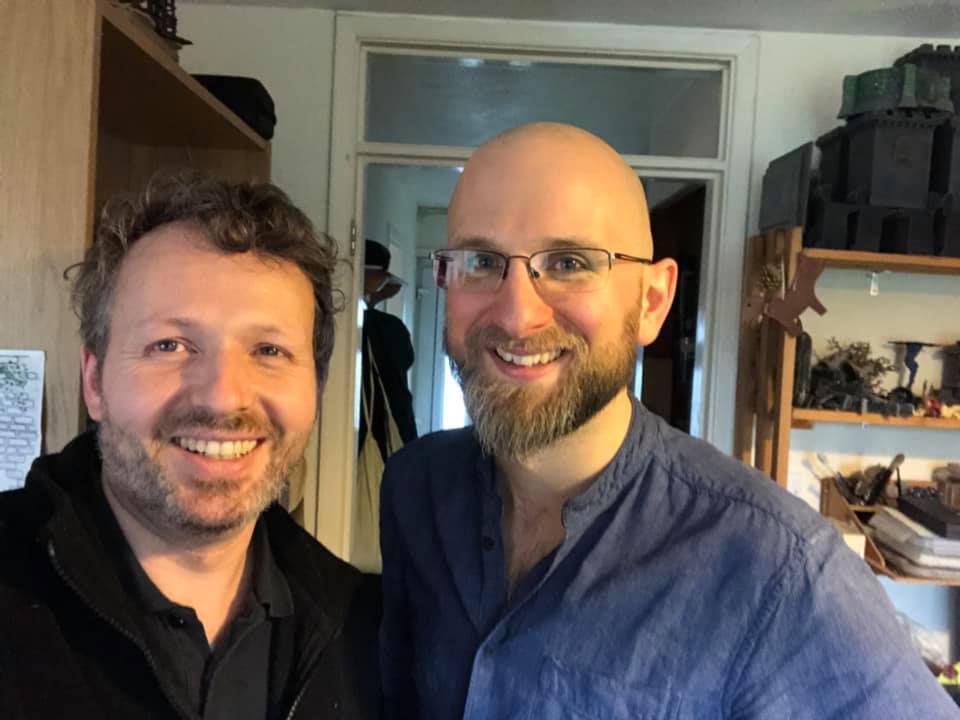
Thanks to a global case of Problems, I don’t see this man again until April 2022, whereupon I meet up with him in Bristol and get my Space Marines politely shithoused by his Harlequins.
Cut to September 2023. Tom asks me, “If I organise a crusade weekend in February down at my place in Devon would you be interested in coming down?” …and I would, yes. I’m honoured to be asked; it isn’t like he’s short of local mates to do this with, and spaces are limited. The chance to meet new Warhams in a relaxed setting is enticing, as my own gaming group is fairly small (there’s only ten of us). I’m somewhat socially intimidated by the idea, but after spending four years working in Oxford’s Warhammer store, much of my social anxiety was rubbed away by handling the shittier parts of the British public who came in to take the piss out of our beautiful plastic space people.
I digress, here’s the important thing: Tom’s being clever. He knows I’ve run narrative campaigns before, he knows I’ve messed with Crusade, and he knows I’ll get obsessively enthusiastic about figuring this one out. I fall straight into the Venus Ham trap. He’s going to handle the logistics, food, all that stuff, and now he’s found someone to run the campaign. “Divide and conquer,” as he puts it. Since I’m used to hosting a lot of Warhammering, I’m used to worrying about the games and the food, so this is a welcome division of labour. Well, OK, my wife often ends up worrying about the food, despite my protestations that she doesn’t have to (she’s a feeder).
Labour thus divided, the planning begins.
Tom: This makes me seem considerably more Machiavellian than in reality! My fantasy scenario for the weekend was to get a bunch of my favourite Warhammerers together and have them game together (and with me). I had this in my head for ages, and to my mind Charlie plays 40k the way I would if I had a brain the size of a planet and more time.
I knew I would be able to get Charlie to help give me pointers, and had planned to do the game planning myself, but as the weekend planning evolved I quickly realised that if I tried to design it as well as do all the logistics it would be a lot on my plate, and I would hold Charlie back – his institutional expertise and game designers brain outpaced mine in every way possible!
So I concentrated on marshalling the participants, organising food and other boring logistical stuff, while Charlie did the alchemy of game design. I really liked this division of labour, because it allowed me to make sure our food was on point, and (I hope) that everyone felt well cared for.
Charlie: You fully succeeded!
The Planning
Planning, Part One: Know Who’s Coming Before Deciding on a Narrative
The maximum capacity of the house we’re staying in is eight people. Tom sets about finding out who’s available and what armies they’ve got. Some of the players own multiple armies, which gives us some flexibility. Eventually it looks like we can do four Chaos armies, so that’s one side sorted. Inevitably we can immediately fill the other side with Emperor-botherers and some semi-friendly Ynnari. Tom: I do own an Imperial army, but I played the “I’m host and I want to play my army because I want to” card. And Charlie wove it in seamlessly!
Team Chaos
Dark Mechanicum
World Eaters
Iron Warriors
Fallen
Team (mostly) Imperial
Grave Apotheons (Astartes)
Cobalt Scions (Astartes)
Custodes
Ynnari
Planning, Part Two: Settle on the Basic Format
Tom and I talk on the phone and go back and forth hashing out the basics. I don’t know the players or their group’s habits, so I treat Tom’s hopes for the weekend as my design brief. He’s keen for the weekend to close with a big team game, a bit of spectacle. Prior to that, it’s more of a round robin, so we’ll play multiple small games and play each member of the opposing team. Three games each on the Saturday, another small game on Sunday morning, then the team game. He’d like there to be a spot of Crusade Lite, but isn’t sure what that’d look like. I tell him it’s fine, that’s enough for me to work with.
Planning, Part Three: Story Requirements
Tom tells me he’d like the campaign to be set in their group’s setting-within-the-setting, a backwater region called the Graven Reach. He sends me a PDF to get me up to speed. It’s all properly laid out in the style of the Heresy books and everything. I read through the stuff; seems like the Graven Reach got fought over during the Heresy and has been largely ignored since then. No big bustling Imperial worlds; it’s all crusty outposts, frontier towns and pirate bases. That’s fine, I’ve got terrain that can represent that on the table, and he can bring terrain from his gaming club too. If we didn’t have the right terrain, I’d be suggesting another story, just like one must know which armies are turning up before getting one’s pen out.
This may help explain my absurd terrain collection.
As for the story itself, he’s keen to tie it into a plotline from their Heresy-era campaigns. The Dark Mechanicum player’s warlord is obsessed with stuffing daemons into ever larger constructs. He eventually achieved daemonhood, but was banished to the warp before he had a chance to try the process on a titan. That’s where this group’s 30K narrative finished, and now, ten thousand years later, crazy Ma’Ta is back from the warp and having another crack. Apparently one of the players has a Warhound Titan we can use to represent Ma’Ta’s latest, dodgiest project.
Planning, Part Four: Putting It All Together
OK. So. Round robin. Crusade elements. Small games. Team game. 30K callback. Possessed titan. The easiest way to tie all these things together? Ask questions, derive answers.
Q: The campaign’s taking place in a total backwater that the Imperium hasn’t cared about since the Heresy. How has the Imperium become aware of what Ma’Ta’s doing?
A: The only person you’d find digging through old tech from Heresy-era battlefields is a technoarchaeologist. Let’s say one discovers Ma’Ta by mistake, gets stranded, and therefore sends out a distress call. Imperial rapid response elements come running, but they’re not the only ones who heard her communication. The rapid response thing would also fit with all the players having fairly elite armies rather than more cumbersome factions like the Imperial Guard.
With Chaos and Imperial forces converging on her ship, that also helps with the ‘small games’ brief, since we can fight a bunch of boarding actions to determine the fate of the technoarchaeologist.
Q: What will the players fight over other than the titan during the campaign?
A: We can’t have the titan powered up in a small game, so this campaign must be about getting the titan online. That means fighting over fuel and other materiel to get it working. But also, if we’re going to do boarding actions, that suggests the technoarchaeologist’s ship is big enough that it hasn’t been fully defeated by the local forces, and might still be saved. This way, it’s not all about the titan, it’s also about rescuing people and assets.
Q: How to play Crusade without it being too much bookkeeping for a weekend?
A: Don’t. Crusade is designed for lots of games over a long period of time; it’s not designed to work as a standalone weekend thing. Maybe just pick one unit that did well in each game and give it an upgrade, then rather than agendas have loot crates to unlock weapon enhancements. That way, people without codexes aren’t disadvantaged, and there’s almost no bookkeeping (note: these rules are fleshed out properly later in this article).
Tom: Seeing this all laid out is such a great example of how necessity can be the mother of invention. In our conversations I sometimes felt as if I were being a capricious and irritating manager, changing the project brief for an underappreciated colleague! (Charlie: It was my first time on the set of The Devil Wears Warhammer, and I loved it.)
But it’s wonderful how Charlie took the elements and strictures of the format and used those strictures for positive outcome. It’s a great illustration of how his years of experience as a GM for roleplay games gives cross-benefits. It also allowed me to feel that with that continuity of setting and player it was still in some sense my campaign as well.
Charlie: I hammer it all together, then send the following to Tom:
A distress call has been sent by Technoarchaeologist Arikleya Kallisto. Upon entering orbit above the planet Ventosus in the Graven Reach, her explorator battleship Sukalnik was struck in its primary thrusters by an experimental weapon system fired from Ventosus’ moon. The Sukalnik destroyed the facility, but is now stranded. Despite the best efforts of its attitude thrusters, its orbit is decaying.
Archmagos Kallisto’s desire was to follow up on rumours that the planet was once the domain of the old Mechanicum, before the Horus Heresy. There may be relics, and now more importantly, the raw materials needed to repair the Sukalnik before it falls from the sky.
Unfortunately, the thick atmosphere and constant electrical storms of Ventosus prevent orbital scanning, and it is almost impossible to maintain radio contact from the surface. Still, needs must. The Sukalnik launched shuttles and began exploring the surface, finding many ancient ruins. The planet is a forgotten treasure trove, the reasons for its abandonment unclear. Forward outposts were established, watched over by Skitarii, while Kallisto waited for Imperial ships to come to her aid.
The first rapid response vessels are now arriving, but not all bear the aquila upon their prows.
I explain that as the campaign goes on, the Imperial forces will eventually discover Ma’Ta’s forge, and the thing he’s working on. Meanwhile the Chaos forces, mostly drawn by the distress beacon, will become known to each other. Each player will be given a handout at the start of the weekend that tells them who they’re fighting, what mission they’re playing, and how the story progresses from their faction’s perspective. The outcome of certain battles, even from halfway through the campaign, will start to have narrative consequences, the first of which is whether Team Chaos manage to board and capture the Sukalnik.
With the round robin format, the campaign structure I’m going for is what’s known as a tree campaign, where the results of individual games determine where the story goes. I group some of the games together, so if one side wins a majority of the boarding action games, that will determine whether the Sukalnik is captured by Chaos or saved by the Imperium. By contrast, the round of games on Saturday evening where we’re going to use 1,500 point armies, will give the winners certain bonuses in the final team game. I limit the number of outcomes to prevent getting things too convoluted, and those outcomes boil down to:
- Who wins the battle for the Sukalnik?
- Does Ma’Ta complete his possessed Titan, or do the Imperial forces destroy it?
Preparation
Completely Unnecessary Illustrations
I’m a very visual person, and making a map – even if I don’t need one and don’t know how usable it’ll be on site – helps make a campaign narrative feel more real to me. It doesn’t make sense, not really, but since I enjoy making maps, why not indulge myself?
I make one promise to myself, which is that the map will at no point be required for the campaign to progress. That way, if there’s a technical hitch while I’m running something away from home, it can’t stop the campaign. Tom: Nice foreshadowing!
Essentially the map is just a visual way of keeping score, but the same ends can be fulfilled using a pencil and the back of an envelope. But look, if you’re reading this, you probably collect miniatures rather than chess pieces because the miniatures look cooler, so in a way, I’m preaching to the choir here, aren’t I?
Campaign maps need two things: a map, and faction icons to go on it. Happily I can put this together pretty quickly because I can pull in assets from previous projects. What you’re looking at below is a planet from Space Engine, a bunch of frames painted in Photoshop by me, and then (top to bottom): a backlit photo of some city ruins from my terrain collection, a stock photo of a factory from Wikimedia Commons (source), and a screenshot of a Mechanicus ship from Battlefleet Gothic: Armada II, all with static and lines and stuff added over the top to bring them all together visually.
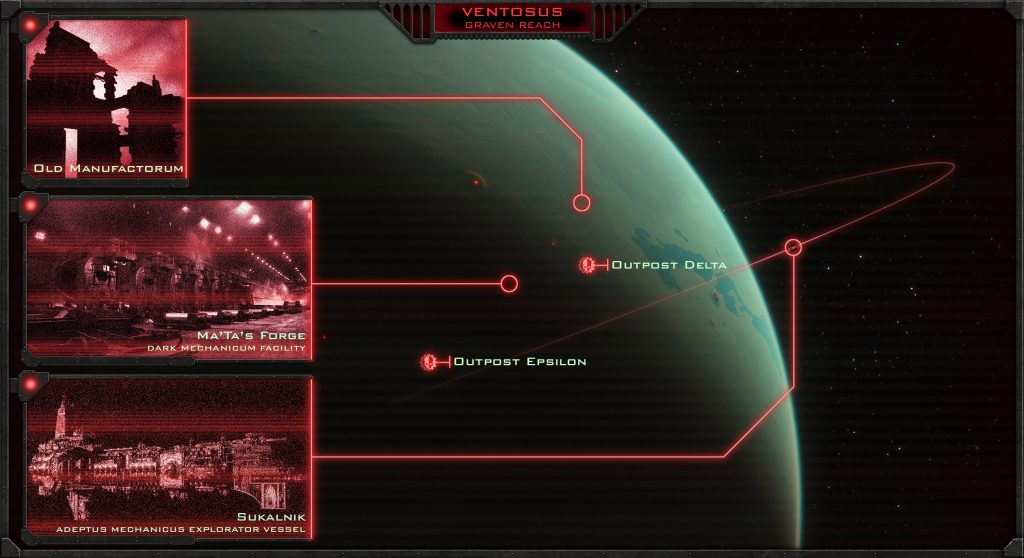
Now for the faction icons. I’ve already done a bunch of icons for big 40K factions, so I decide to use those here to save me time on the (already uneccessary) map, and do the icons I’m missing in the same format to save time and keep things consistent. I’m missing icons for the Adeptus Custodes, the Ynnari, the Dark Mechanicum and the successor marines RJ Bayley is bringing, the Grave Apotheons. Opening Photoshop, I restrict myself to two-tone designs within the frames I’ve previously painted so as not to go off into the weeds. They come out like so:
An Excuse to Finish Some Terrain
The campaign’s set in a backwater, and I have a Killzone box of unfinished Sector Fronteris ruins loitering under my stairs. It’d be a shame to miss the opportunity, so I get working. I won’t completely finish the weathering stage by the time I’m packing the car, but they’ll be finished enough to go on a table.
If you like how these look, you can find the (really rather quick) painting method in this article.
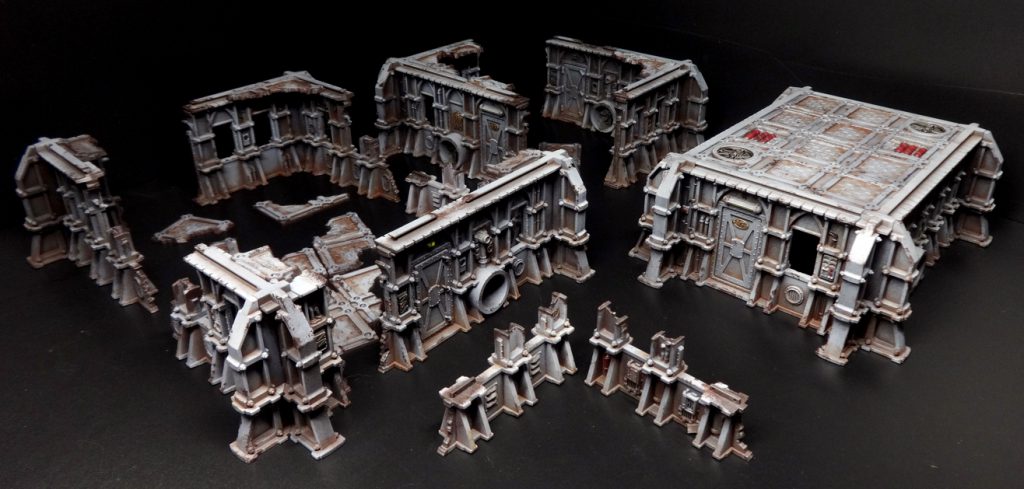
Writing the Players’ Guidesheets
I lay out a spreadsheet so I can figure out the schedule, check with Tom that this is in line with what he’s expecting, then I write a guidesheet for each player so they know who they’re battling and when.
Here’s the first draft of the schedule:

And here’s one such sheet:
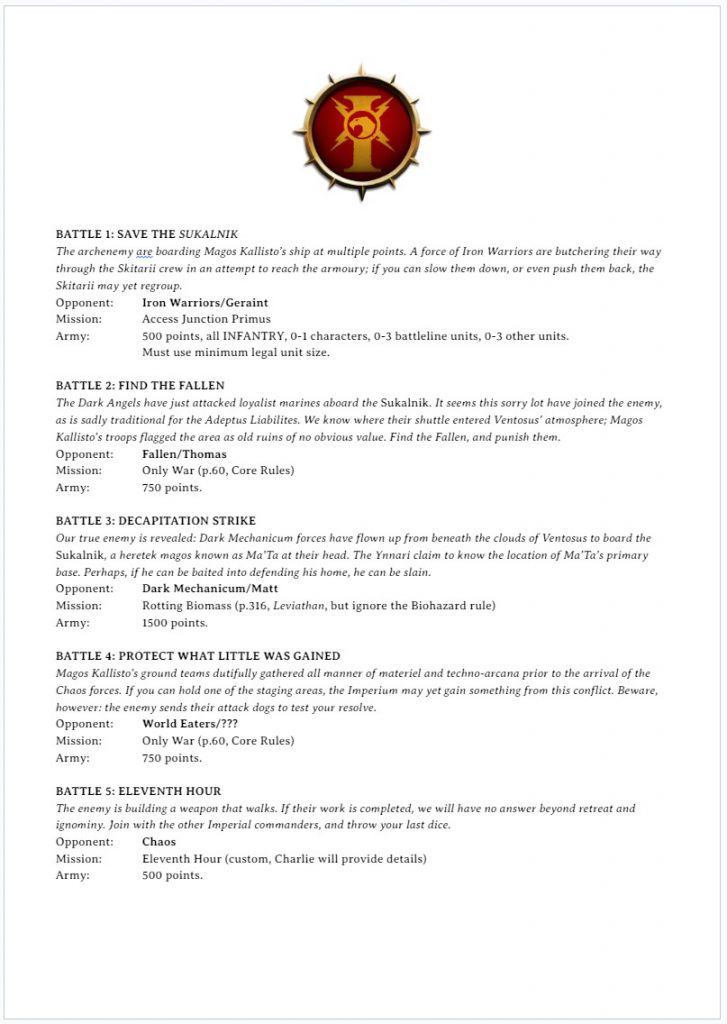
This all seems pretty good, if a little rigid as structures go, at which point a wee spanner goes for a walk in the works.
Oh Damn
For medical reasons that I won’t go into here, our World Eaters player is forced to cancel. He’s gutted (metaphorically).
I rework the schedule to cope with our now-unbalanced teams; Tom and I decide to bow out for a round each, and then round three will involve a team game. No biggie, schedule reworked, problem solved.
Then the Custodes player drops out, also for very understandable reasons that I won’t go into. We also learn that some of the players will have to leave relatively early on the Sunday – as early as 4pm. That makes a game on Sunday morning and a team game on Sunday afternoon look pretty unlikely.
Tom: This was the only point at which I began to have serious concerns about the weekend. I hadn’t run a comparable event before and these dropouts really worried me. This involved Charlie having to do more work than anticipated, and I was worried that it wouldn’t be as good as I hoped. However, after re-assurance that dropouts happen every single time and it isn’t a game-breaker, I recovered from my wobble.
… Rewriting the Players’ Guidesheets
Tom and I decide that, given the smaller number of players, we can do a complete round robin in three rounds on the Saturday, then kick off the final team game on Sunday morning, giving people plenty of time to get home.
I rewrite the schedule again, reminding myself that this is why people who run bigger events just keep score of wins/losses so you don’t have to rework stuff every time there’s a change in lineup. Still, I stick to my guns, as I’m hoping to make the weekend feel more personal than a massively multiplayer event. If the gods will it, we won’t lose any more players before we get to the venue.
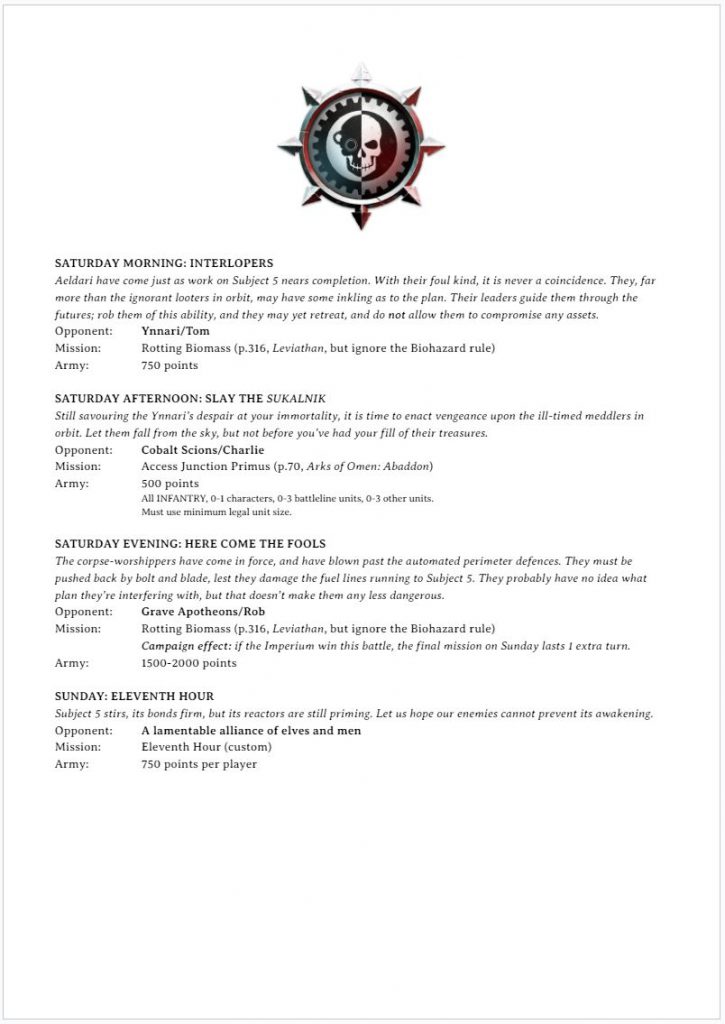
The terminally-curious can read the rest of the player guidesheets in this Google Doc.
Stripping Down Crusade
Crusade isn’t a complete narrative system, it’s a subsystem that handles levelling up. It’s got its selling points, but it’s too cumbersome for standalone campaign weekends. I want to get the bookkeeping down near zero, but I want to use the fundaments of Crusade to act as a replacement for secondary objectives… without needing to use the whole Agendas system. That’s why the schedule makes heavy use of basic missions like the ubiquitous Only War – because I’m adding a touch of complexity here instead.
On the back of every player’s guidesheet, they get the following summary:
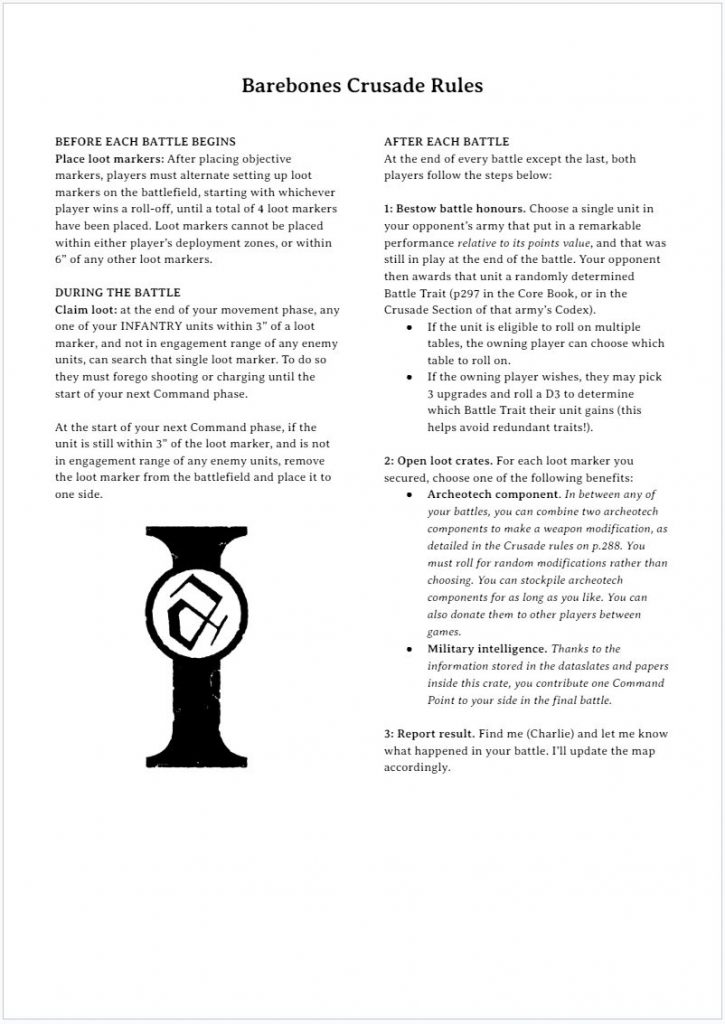
TEXT VERSION OF THE RULES
Time to Leave
With the prep complete, I sling my clothes and army into my little car, and then absolutely stuff it with terrain. The process of packing all this terrain reminds me how lucky I am that people normally come to my place to throw bones. I’m nervous, curious, and excited as I set off. If you’re keen to hear how it goes, Part Two will be here in a few days. In the interim, if you’ve got thoughts or questions about this stripped-down approach to Crusade, the illustrations I did, or anything else, I am always keen to discuss such vital matters with ye, my fellow Warhams. Comment below, email contact@goonhammer.com, or scream at me on Instagram and/or the Goonhammer Discord server.



